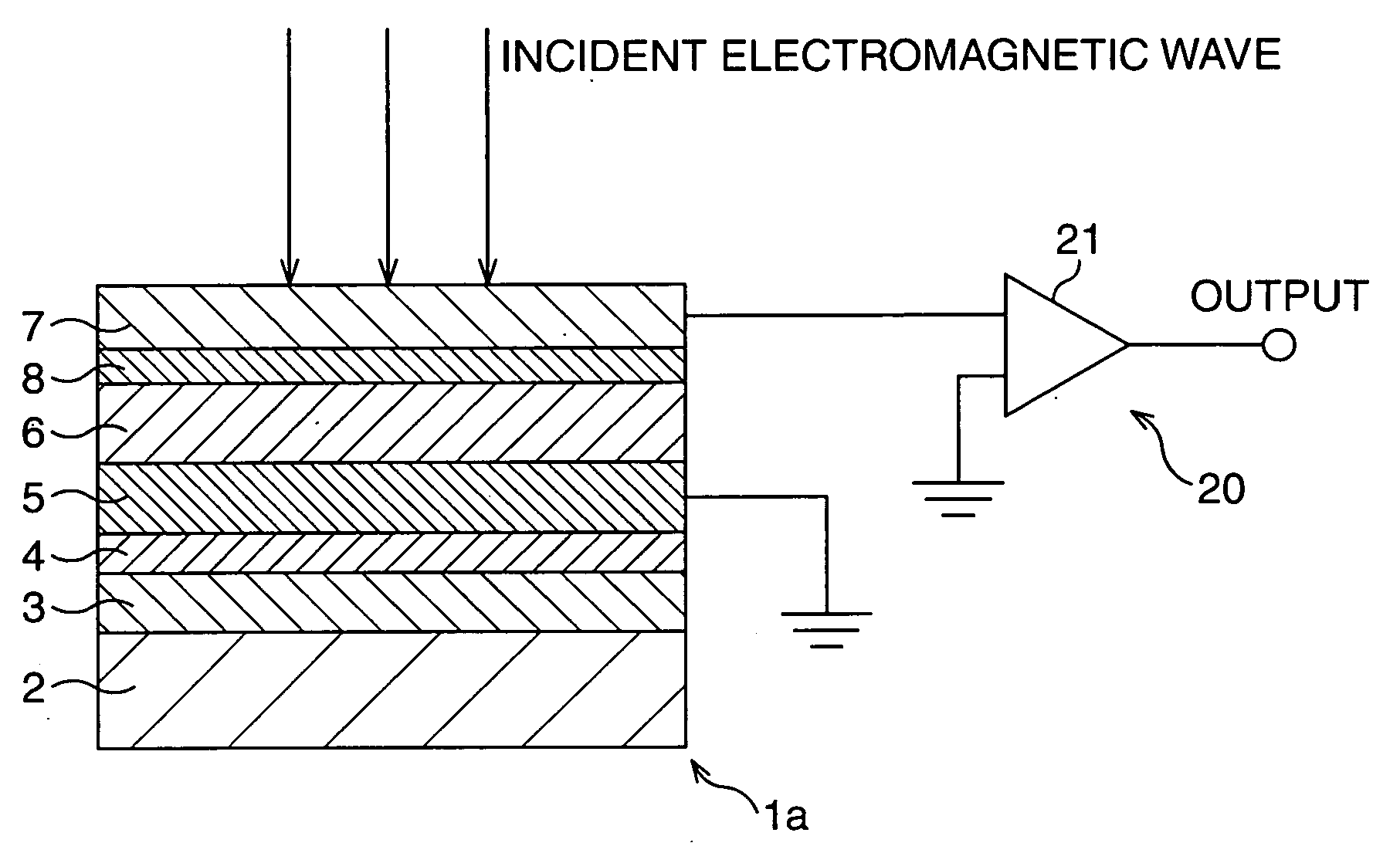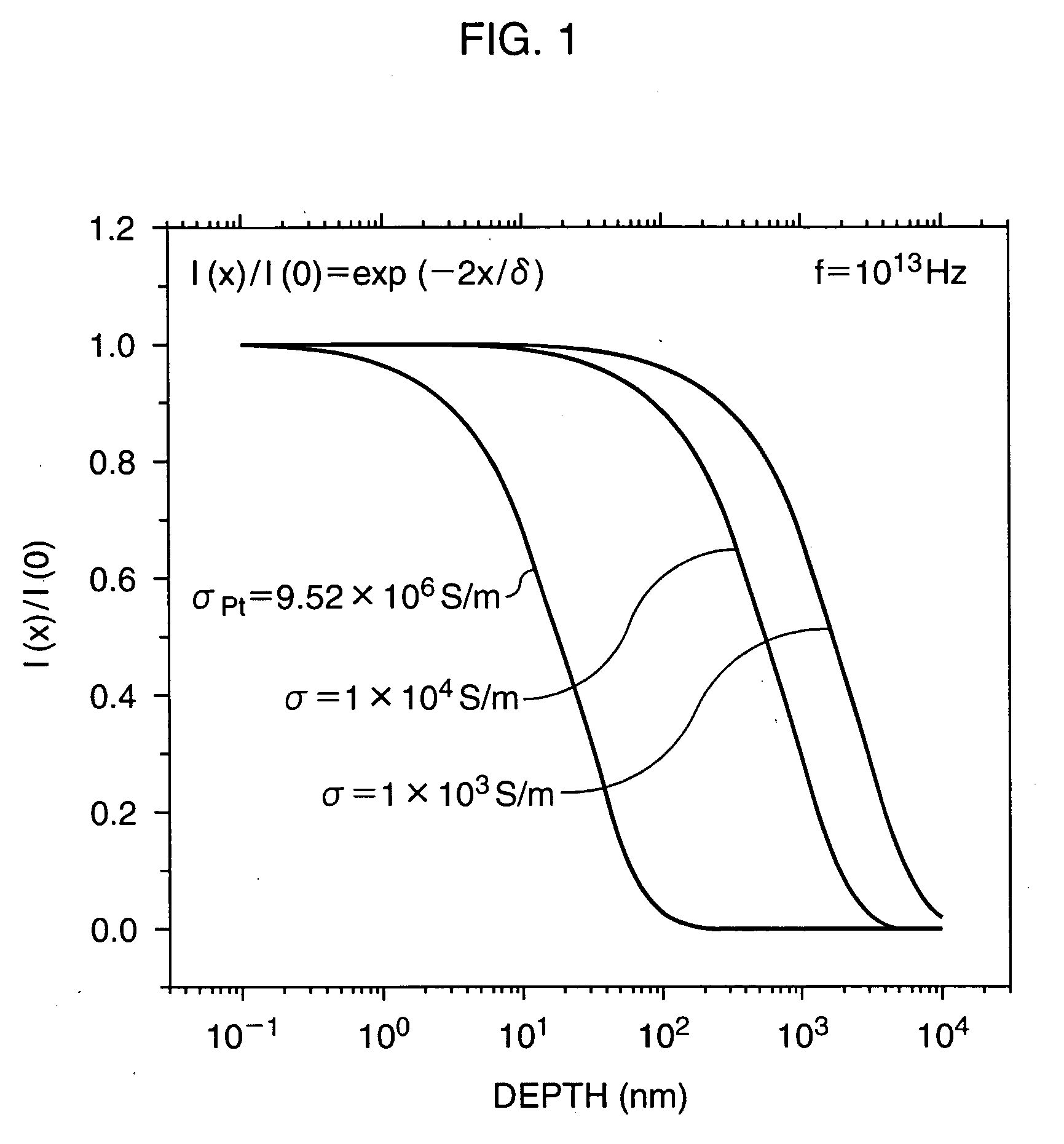Electromagnetic radiation sensor and method for fabricating the same
a technology of electromagnetic radiation and electromagnetic sensor, which is applied in the direction of photometry using electric radiation detectors, optical radiation measurement, instruments, etc., can solve the problems of large amount of incident electromagnetic radiation reflected by metal film, increase the fabrication cost, and significantly reduce the mechanical strength of film, etc., to achieve easy fabrication and high sensitivity
- Summary
- Abstract
- Description
- Claims
- Application Information
AI Technical Summary
Benefits of technology
Problems solved by technology
Method used
Image
Examples
first embodiment
[0035] The first embodiment of the present invention will be described below. FIG. 3 is a schematic view showing the structure of a thin-film electromagnetic radiation sensor according to the first embodiment of the present invention.
[0036] In a thin-film electromagnetic radiation sensor 1, an SiO2 layer 3, Ti layer 4, Pt layer 5, PLZT ((Pb,La)(Zr,Ti)O3) layer 6, and IrO2 layer 7 are sequentially formed on an Si substrate 2. The thicknesses of the Ti layer 4, Pt layer 5, PLZT ((Pb,La)(Zr,Ti)O3) layer 6, and IrO2 layer 7 are, for example, about 20 nm, 100 nm, 200 nm, and 100 nm, respectively.
[0037] Although the Ti layer 4 is formed as an adhesive layer which adheres the Pt layer 5 as a bottom electrode and the Si substrate 2, the Ti layer 4 also functions as a part of the bottom electrode. The PLZT layer 6 is a ferroelectric layer and formed by, for example, a sol-gel method, RF sputtering method, or metal organic CVD (MOCVD) method. The IrO2 layer 7 functions as a top electrode. T...
second embodiment
[0042] The second embodiment of the present invention will be described below. FIG. 4 is a schematic view showing the structure of a thin-film electromagnetic radiation sensor according to the second embodiment of the present invention.
[0043] A thin-film electromagnetic radiation sensor 1a differs from the thin-film electromagnetic radiation sensor 1 according to the first embodiment in that a Pt layer 8 is formed between a PLZT layer 6 and IrO2 layer 7. The thickness of the Pt layer 8 is equal to or smaller than a skin depth, and is about 5 nm, for example. The Pt layer 8 is formed by DC sputtering method.
[0044] In the thin-film electromagnetic radiation sensor 1a having the above arrangement, the presence of the Pt layer 8 makes the height of a barrier higher by about 0.8 eV to 1 eV than that in the thin-film electromagnetic radiation sensor 1.
[0045] Note that in the fabrication of the thin-film electromagnetic radiation sensor 1a, it is preferable to form the Pt layer 8 and Ir...
third embodiment
[0047] The third embodiment of the present invention will be described below. FIG. 5 is a schematic view showing the structure of a thin-film electromagnetic radiation sensor according to the third embodiment of the present invention.
[0048] In a thin-film electromagnetic radiation sensor 1b, an SrTiO3 layer 16 and IrO2 layer 7 are sequentially formed on an n-type Si substrate 12. The thickness of the SrTiO2 layer 16 is, for example, about 100 nm. The SrTiO3 layer 16 is formed by pulse laser deposition method or RF magnetron sputtering method, for example.
[0049] In this embodiment, the n-type Si substrate 12 functions as a bottom electrode, and the IrO2 layer 7 functions as a top electrode.
[0050] The same effects as the first embodiment can also be obtained by the thin-film electromagnetic radiation sensor 1b having the above arrangement.
PUM
 Login to View More
Login to View More Abstract
Description
Claims
Application Information
 Login to View More
Login to View More - R&D
- Intellectual Property
- Life Sciences
- Materials
- Tech Scout
- Unparalleled Data Quality
- Higher Quality Content
- 60% Fewer Hallucinations
Browse by: Latest US Patents, China's latest patents, Technical Efficacy Thesaurus, Application Domain, Technology Topic, Popular Technical Reports.
© 2025 PatSnap. All rights reserved.Legal|Privacy policy|Modern Slavery Act Transparency Statement|Sitemap|About US| Contact US: help@patsnap.com



